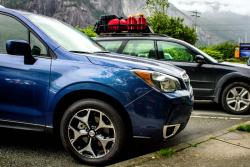 2014 Subaru Forester XT Touring. Click image to enlarge |
Review and photos by Brendan McAleer
Stuck behind a logging truck on the Sea-to-Sky highway is no place to find yourself. The road twists and turns, revealing alpine vistas and postcard-perfect peaks, and all I can think about is that one part from those stupid Final Destination movies where all the logs break their chains and come cartwheeling through the windshield as though the car was suddenly under attack by a militant wing of the Scottish Highland Games Society.
At the time, I was behind the wheel of a 170-hp Limited-trim Forester, and while that particular car has perfectly adequate power for most situations, it’s not quite enough to attempt to get around a heavily laden semi, currently travelling at about 10 km/h under the limit. The truck’s too long and the passing areas are too short; I lift off the throttle to open up a little more room between the Forester and the rain of bark chips that stream out behind the logging rig.
A very brief dashed line appears, but better not chance it, I figure. And just at that moment, a silver Forester XT goes slinging past both of us, turbocharger whistling away merrily and engine pinned in the powerband – sometimes a little extra power is actually a safety feature.
A short time later I got my hands on the turbocharged version of Subaru’s all-new Forester and took it up the same road. As you’ve already read in previous reviews, this fourth-generation Fozzie is larger, lighter, spacious-ier, and considerably more fuel efficient. It swallows gear with ease, accommodates child seats no problem, fits in-laws in comfort and has a stellar safety rating – best in the segment.
As such, it ticks all the Dad boxes, and as somebody who hits the local trails regularly (though not regularly enough to look like Bear Grylls instead of Winnie the Pooh), the whole outdoorsy vibe of the Forester fits in perfectly with our family’s muddy-booted ethos. Standard factory roof rails? Good stuff. Decent road clearance and an “X Mode” for handling rough descents? We’d actually use it. Plus, I already own a turbocharged Subaru product, of which I’m almost sappily fond, so the go-fast version of the Forester should fit like a woollen sock in a Welly, right?
Let’s talk about drivetrains for a minute. Subaru will still offer you a six-speed manual in both base and Touring trims of the four-cylinder naturally aspirated model. May Our Lady of Acceleration bless them for it. Everything else, including the turbocharged XT, gets a continuously variable transmission (CVT).
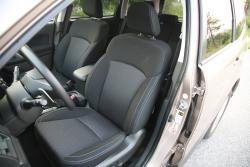 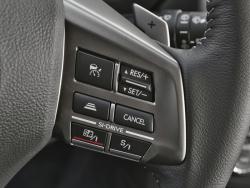 2014 Subaru Forester XT Touring. Click image to enlarge |
The CVT is perhaps the most-maligned transmission on the planet as far as the enthusiast community goes, taking a kicking for everything from excessive whine to the unchanging accelerative feel of a motorboat. The decision to only offer the hi-po Fozzie with this snowmobile gearbox therefore looks like folly in the extreme. Remember how great the old five-speed manual Forester XTs were? Like a big floppy WRX with the styling lines of a toaster and the soul of a rally car.
But you haven’t been able to buy a manual-transmission turbo Forester for a full generation. Instead, buyers got stuck with the old four-speed automatic – an antediluvian transmission that predates agriculture. But say what you like, the four-speed was tough as nails and worked hand-in-hand with the torquey 2.5L turbo to provide strong acceleration and durability. Er, except for the engine’s headgasket issues, but they mostly fixed that.
This new turbine-fed Fozzie gets a 2.0L, direct-injected flat-four that produces a full 26 hp and 36 lb-ft of torque over the previous engine (how’d they do that? More boost.) and also gets a unique, beefed-up version of Subaru’s Lineartronic CVT. This last is an entirely in-house design with a steel drive belt, Subaru preferring to develop their own CVT rather than license a lighter-duty option from CVT-championing Nissan.
Like the Nissan and Honda transmissions, Subaru’s CVT consists of a pair of hydraulically actuated pulleys and a gearless friction belt strung between them. CVTs have been around since the late nineteenth century (not an exaggeration) and in the bad old days used to actually be made of rubber. These days, the drive belts are made of aluminum, as in the Nissan, or steel, as in the Subaru application. Like the changeable fore-and-aft gearsets of a 21-speed bicycle, a CVT transmission can seamlessly flow through any ratio between highest and lowest. Fuel savings are maximized by keeping engine revs as low as possible, and acceleration is theoretically improved by maintaining an engine in its powerband during passing maneuvers.
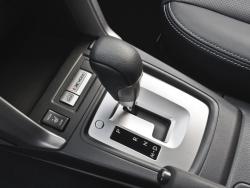 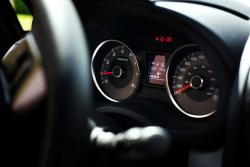 2014 Subaru Forester XT Touring. Click image to enlarge |
The new 250 hp, 268 lb-ft of torque turbocharged two-litre engine utilizes direct fuel injection for more precisely-metered combustion – injecting fuel directly into the cylinder also has a cooling effect on the air, always important where a forced-induction engine’s turbine is ramming in hot air (and speaking of which, a brief moment of silence for the Forester’s now-defunct nostrilly hood scoop). The turbocharger is a twin-scroll unit: sounds a bit like Dungeons & Dragons spell requirement, but it’s actually a splitting of exhaust gasses to provide better low-end response without losing top-end power. Essentially, a smaller port focuses the exhaust stream to spin the turbine up more easily at low volume flow (low rpm), while a larger port provides better flow-through when things are humming along.
The engine is also fitted with a timing chain, which should please anyone who’s had to pay big dollar for a t-belt job on their Subaru – flat-four motors have a lowered centre of gravity, but can be hard to access for service. Also of good news to those looking at down-the-road maintenance costs, the entirely reworked coolant flow looks like Subaru may have licked the head gasket issue for once and for all – stay tuned, I suppose.
From where I’m standing, the power bump from the new drivetrain is both good and bad. The good: increased performance, and considerably increased fuel economy at 8.9/7.2 L/100 km officially, theoretically burning just a litre more fuel on the highway than the naturally aspirated 2.5L option. The bad: say goodbye to the old modification-friendly Subaru, as putting more power through this CVT could be disastrous. Durability has historically been a problem in Nissan units, and a CVT is a replace-not-rebuild component.
Of course, only a small segment of a small segment would ever actually want to try to put together an STi version of the XT, a niche so small Subaru stopped catering to it. A shame, that.
For the rest of us, the way it drives in the factory setup will have to do – and it’s not bad. The steering is a bit numb and overboosted – par for the Subaru course – and compared to something like a Mazda CX-5 or Ford Escape, the Forester leans far more in the corners, even this 18-inch-alloy-shod XT with its stiffer suspension.
However, as you’d expect from a Subaru, it also feels incredibly planted. Naturally aspirated models with the six-speed manual are mechanically split 50/50 while CVT-equipped Foresters are biased 60 percent in favour of the front wheels until slippage occurs, at which point an electrically controlled multi-plate clutch splits power up to 50/50. Don’t think of it as a slip-and-grip system as in some other competitors though – the Subaru puts its power down very well.
In fact, the XT drives sort of like a heavyweight Juke. That’s a compliment by the way – while the insectoid Nissan looks like something Jabba the Hutt would put in his trail mix, it’s thoroughly engaging to drive, and the Forester is similarly good. Those complaining about the snowmobile transmission might remember just how much fun a snowmobile actually is.
Throw the Forester into a corner and it digs in with pronounced, nay, enunciated body roll and a bit of nice safe understeer at the limit of the all-season tires. Powering out of the corners is something entirely different – the XT loves to blast out under throttle, and with the turbo fully spooled, it’s like being fired out of a slingshot. No tail-wagging BRZ behaviour here, just honest Subaru all-wheel-drive grip.
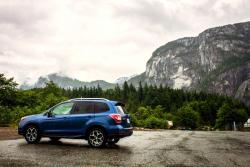 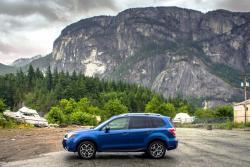 2014 Subaru Forester XT Touring. Click image to enlarge |
Three modes are available for throttle and transmission sensitivity, with normal mode being the most fuel-friendly and Sport# (“Sport-sharp”) cranking up pedal response and giving you eight stepped ratios that can be shifted through using the paddle shifters. Sport mode splits the difference with six artificial ratios, and honestly, while Subaru has done a pretty good job of synthesizing the feel of a dual-clutch, I’d be inclined to just let the CVT sort it out.
The more the road curves, the better the Forester got into a rhythm with its driver. What it feels like – and this should come as no surprise – is a car set up for gravel rally, with long-travel suspension and soft spring rates. Obviously, this behaviour will please the Subaru faithful if they can get over the new CVT transmission (hey! Remember the Justy? No? That’s probably for the best…) and the elimination of the V6 option in most competitor products does leave a niche for the turbo-Forester, especially now that it carries twin gold medals around its neck from Consumer Reports and the tricky IIHS small-overlap crash test.

























Best of all, there is a price overlap between the Touring model of the XT (at $32,495) and the leather-lined 2.5i Limited ($33,295). Yes, the Limited with the normally aspirated engine has 10–15 percent fuel efficiency advantage – a gap that’ll grow depending on the lead content of your right foot – but given the choice between solid performance and a few luxury goodies, the Gore-Tex wearer in me would lean heavily towards the cloth-seat equipped turbo model. You can even fill it with regular-grade fuel if you don’t need every last horse.
|
Related Articles: Manufacturer’s Website: Photo Gallery: |
Safe, spacious, very quick, reasonably efficient and set up like a cross-country mountain bike. If you’re looking for a do-all crossover and don’t mind a little less refinement, it’s a caber-toss ahead of the competition.
Pricing: 2014 Subaru Forester XT
Base Price (XT Touring): $32,495
Freight: $1,650
A/C Tax: $100
Price as tested: $34,245
Crash Test Results:
National Highway Traffic Safety Administration
Insurance Institute for Highway Safety











